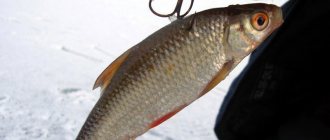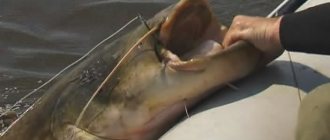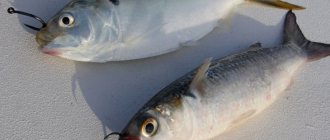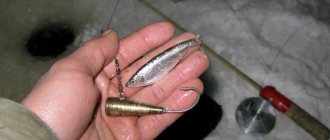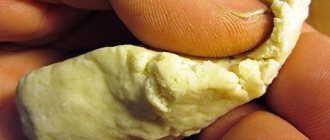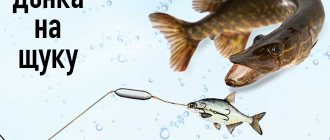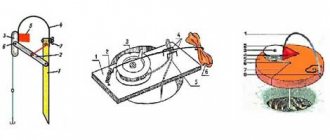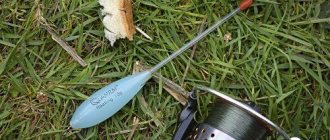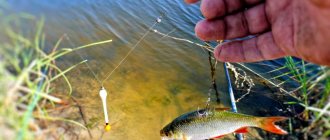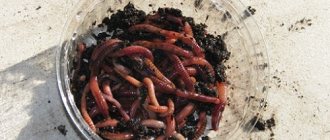A huge hello to all anglers! In this article, the site ryba4ok.ru will tell you how to properly place live bait on a hook, which hook is better to use - double, tee or single and why. You will learn the best and most effective bait methods for catching fish such as pike, perch, pike perch in currents and in still water.
Each method has its positive aspects and is better suited for use in a given situation, for catching a particular fish. Let's take a closer look at each of the methods. To make it as clear as possible, the article will be supplemented with visual photos and videos. Go!
How to put live bait on a hook: classic method No. 1
If you are not a fan of experimenting and inventing anything, then the classic method is suitable for you - by the dorsal fin. This method is definitely the most popular because it is both simple and very effective. When baited in this way, the bait on the hook looks very natural, slightly showing signs of a wounded fish, which acts on the predator as a call to attack.
But, in order to successfully catch a predator using this method of baiting with live bait, you need to know several very important rules in order to use the effectiveness of the method at 100%.
So, it is very important to bait the bait in such a way that it causes minimal harm to it and it remains active for as long as possible. To do this, it is enough just not to damage the fish’s ridge, which runs approximately in the center of its body. Try to insert the sting about 3 mm below the fin, then the live bait will stay securely on the hook, and its spine will remain intact.
As a result, your bait will be active for a long time and actively attract a predator all this time. Predator bites on dead live bait will occur much less frequently, or pike, perch or pike perch will not be interested in it at all.
The second important point is that the position of the live bait should be as natural as possible. In its natural environment, the fish usually swarms in the ground in search of food, so its usual position is at an angle to the bottom with its tail slightly upward. Therefore, when placing live bait on a hook, you need to hook it slightly moving the center of gravity forward so that the head tilts.
It doesn’t matter how much the bait fish’s head is tilted; you can experiment with different tilt angles. But, approximately, it should be at an angle of 30-45° to the bottom.
Attention: live bait hooks under the dorsal fin with only one hook, regardless of whether you use a single hook, a double hook or a treble hook.
What time to catch minnow
The gudgeon is active during daylight hours. To search for food, he chooses illuminated areas of the reservoir where the bottom is sandy or pebbly. Minnows move quite quickly in the water column, and this is facilitated by their spindle-shaped shape. In the dark, the gudgeon hides at the bottom.
Regardless of the time of day and month, the gudgeon prefers places where there are deposits of silt on the sand. They do not leave the selected area for a long time and do not travel long distances.
You can go fishing for gudgeon as soon as the ice disappears in the spring or frosts do not set in before winter. It leaves for the winter at the end of November, hiding in the thickets of reeds and reeds. But, despite this, it can be caught in the winter months, when the turbidity settles after the autumn rains.
Read! Catching catfish using kwok
Method number 2: “Through the gills”
The way in which the fish is not injured and remains alive for as long as possible is to thread a double through the gills. Thus, the fish is absolutely not injured and remains active for a long time. To do this, you need to unfasten the hook from the leash, thread it under the gill cover of the baitfish from the outside and bring the leash out through the fish’s mouth. Now we hook the double to the leash again.
Please note that this method requires a double. When the double is again attached to the leash, pull it by the leash so that the fore-end is completely inserted into the mouth of the baitfish, and the stings stick down, bending under it.
This method is very good, the fish are perfectly hooked on it, and often even hook themselves. But here it is very important to use a very soft leader so that the fish behaves naturally in the water. And when fishing for perch or pike perch, it is better to use a braided cord as a leash.
Suitable accessories
Light float rods 3-6 meters long are often used for fishing. Take a thin fishing line. The float used is a light one - feather or factory made plastic. If the bait is a worm, then use a regular hook No. 6 - No. 8. If there is a bloodworm, then use No. 10 - a hook with a long shank.
The float tackle is cast in such a way that the hook is very close to the bottom, sometimes touching it.
In places where there are a sufficient number of minnows, fishing can be done with 2 hooks. In this case, the top one will be 4 centimeters higher than the bottom one. He is tied on a short leash. The gudgeon catches very well in spring and summer on worms and caddis. In late summer and early autumn, bloodworms will work better.
If the number of fish is insufficient, it is better to fish with a worm, whole or half. In places where there are riffles, the best bait option would be a piece of a worm.
If bloodworms are used as bait, it is better to place it on the hook so that the sting passes under the head. The gudgeon is less willing to bite on maggots or ant eggs, and even less willingly on bread.
Winter gudgeon fishing
With the onset of frost, the fish go lower to the bottom, but do not leave the river. Although fishing for gudgeon in winter is not as effective as in summer, it can be caught from the ice using a jig. To find winter fish stops on the river, it is advisable to know where the sandy bottom is under the ice. In this case, the depth should not be lower than average if fishing takes place on a small river.
Recommended reading: Carp fish
If the bottom topography is unknown, you will have to drill many holes. Particular attention should be paid to steep banks, river turns, and depressions near open rifts. It should be remembered that the ice on rivers is very heterogeneous in thickness. Even in cold weather there is a danger of falling through the ice!
Fishing methods
There are several ways to catch minnows:
- Into the wilderness. In other words, fishing in troubled waters. To do this, the fisherman should stir up the soil that has settled at the bottom, in places where fish accumulate. You can use your hands, a stick, or just walk around a little. Typically, this method of catching gudgeon is practiced when fishing with a short fishing rod.
- Into the wiring. For this fishing method, use a light fishing rod with a small float and a small hook; you can also use a half-bottom fishing rod. The load, in this case, will be a pellet of the required mass. The bait will drag along the bottom; at the slightest delay, the float will react with a soft hook.
- With self-submersible float. Suitable for fishing in shallow waters where there is a high-speed current. In this case, the bait should also drag along the surface of the bottom. Often 2 hooks are used, the distance between the top and bottom is on average 10 cm, the garter is on a short leash.
Method number 3: “By the nostril”
The method of baiting by the nostril is as safe for the health of live bait as the previous one, only it is more suitable for fishing in the current. Live bait mounted in this way holds perfectly on the stream and behaves very naturally. The predator will never suspect that danger may await him.
Installation is extremely simple - one of the hooks is threaded through the nostril, but carefully so as not to damage the vital organs of the fish. The sting can be removed through the second nostril or near the eye of the fish.
Method number 4: “By the lip”
The method of attaching live bait by the lip is considered very popular. That is, in essence, you hook the fry in the same way that the fish itself is hooked when fishing. You can hook it separately to the upper or lower lip, or to both at once, passing the hook through the lower lip and out through the upper lip.
This method is also harmless to the fry and helps it remain active for a long time, just like the previous one. It is used mainly when fishing with a float rod in the current. The method is distinguished by excellent bite rates and a high percentage of fish self-hatching.
Method number 5: “The tricky way”
The method when the hook does not injure the fish at all and does not thread it into any place is called a cunning method. Although, in fact, everything is ridiculously simple - a rubber band is put on the fish’s tail and the hook is placed under it. Instead of an elastic band, you can use fishing line or thread to wrap the tail of the fish.
The method is reliable, the live bait will not go anywhere and, at the same time, will remain as active as possible almost the entire time of fishing. But this method also has disadvantages. For example, the percentage of pike bites rarely exceeds 50%, since this predator has the custom of grabbing its prey across the body.
That is, initially the hook does not fall into its mouth. And with further swallowing of prey, the pike can either prick itself on the hook and throw out its victim, or simply suspect something is wrong. Other predators such as perch, burbot, pike-perch and catfish are excellently caught when baited with live bait in this way. But to catch pike with live bait, it is better to use another method.
These 5 methods are the most popular, proven and effective. The site ryba4ok.ru chose them based on its experience and recommendations from experienced fishermen. You can safely use any of these methods, and be sure to write about your fishing results in the comments.
Feeding minnows
As bait, I use a slurry (a mixture of sand and clay) with chopped worms, bloodworms or maggots mixed into it, and maggots are sometimes even better, since when they crawl out of the ball of bait, they inevitably fall apart. Good results are obtained by simply throwing lumps of earth from the shore of the reservoir to the fishing point. A stationary feeder is also very good, filled either with small bloodworms or with a dregs-producing composition based on light crackers and bran with egg powder and dry milk. A stationary feeder is convenient to use for attaching fish; besides, bait (especially bloodworms) is spent more economically and efficiently in this case. One feeder with bloodworms is enough for a whole day of fishing.
The most difficult thing is to choose the right feeding point along the current. A mistake will lead to small roaches, minnows and silver bream pecking instead of minnows. The easiest way to choose a feeding point is on a small river with clear water, when the fish can be seen visually. But then you can make mistakes if the currents are unstable.
In a deep place, when it is not possible to visually monitor the movements of the gudgeon, you must first find its site and only then feed it. At great depths, the gudgeon leads a relatively sedentary lifestyle and does not move from the selected stream for a long time. The greater the depth, the more successful the feeding is. By the way, the deepest places near the riverbed are occupied by the largest individuals. If there are a lot of minnows in the river, then you can be sure that among them there will be individuals measuring 12 and even 15 cm.
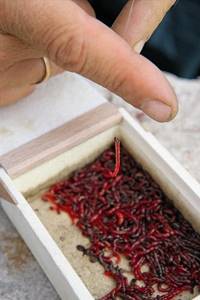
The choice of gear and fishing technique depends on the fishing criteria. It should be noted that the gudgeon in the vast majority of cases takes bait from the bottom. Since the sites of this fish are rarely located at a significant distance from the shore, I fish either with a pole or a light fly rod. Wiring to hold the bait at the fishing point on the bottom, both in uneven currents and in still water, involves the use of the simplest equipment. During the current, the sinker with a hook can be replaced with a jig with a small hook that has a long shank, since this fish has a small mouth. This type of rig is good in shallow water with current.
At a depth of more than 1 m, I always use a rig with a hook. It is very important that the equipment is located above the fishing point; in this case, it is necessary to exclude the “walking” of the float, and therefore the bait from side to side. To do this, I select a stable float. Most often I choose a long float with an extended upper body. If I fish with a piece of worm or in a strong current, I choose a float with a thick antenna.
If the depth is deep and the fish stands in the deepest place, as large gudgeons like to do, I use a plug with a Shark Cralusso float. It is very interesting to catch minnows without bait in small places, visually looking for large specimens. In shallow water near the shore, near vegetation, from a school of three dozen fish you can almost always select two or three specimens of valiant size.
Which hook is best to use for live bait fishing?
If you are not yet an experienced fisherman or have simply never fished with live bait, then a logical question will arise - which hook is better to use? After all, you can fish using a single hook, a double hook or a treble hook.
Here I have clear advice - to optimally use a double. The double incorporates the advantages of both the single hook and the treble hook. At the same time, it practically negates all their shortcomings.
The problem with a single hook is idle bites, since the fish can attack the bait from the wrong side or slightly past the hook. A tee solves this problem, but often a predator, having pricked itself on it, refuses to further attack the bait and does not bring the matter to a confident bite.
The double hook is at the same time not as rough as the treble hook and, at the same time, much more effective than the single hook. It is precisely based on these considerations that it is the best option. There are even special doubles, in which one hook is smaller and the other is larger - this is done so that the bait is less injured. As you might have guessed, the smaller hook is designed for baiting bait, and the larger one is for attacking predators.
Features of choosing bait and bait for burbot
From season
The best time to catch burbot is from mid-October to early May. Burbot is most active during the cold season. A break in fishing may occur during spawning.
The end of October is marked by the pre-spawning feeding of this fish, so it will swallow the bait almost without looking or examining it. You can use any convenient bait.
In the summer, it is almost impossible to lure burbot out of hiding; the fish is very sleepy and does not bite well. The best time in summer is cloudy, cold weather. You can use dead and frozen fish, frogs, and worms as bait.
A good time to catch burbot is early spring. In bad weather, you can count on a larger catch here than when fishing on a clear day. But it is best to catch burbot at night, because it is at this time that he is not very picky about food; he is also attracted to worms, frogs and any fish.
Winter is the ideal time to catch burbot, and this time should also be used to look for fish sites. Thanks to ice, you can try many places and find out exactly where the fish are. In winter, you can catch burbot with almost any bait: live bait, worms, shrimp, meat.
From the gear used
The most popular gear used in winter is winter bottom fishing rods. If fishing is passive, then they use girders. You can use any fish, worms, chicken giblets, or shrimp as bait. For winter fishing, you can also use tackle for the last vertical lure. Here you can use fillets of any fish, larvae, frogs, worms.
Very often, fishermen use fishing rods with a spoon; fishing rods with a jig are also good. Before choosing bait for a fishing rod with a spoon, you need to remember that you need to choose a fish for bait as close as possible to the fish that burbot feed on.
You can also catch burbot using large homemade jigs; their shape should resemble a cone. You can also attach a smaller tee to the bait. The bait should be light in color and shiny to attract fish. You can also use pieces of dead or frozen fish. Donka for burbot is also popular because it does not require expensive parts. Often fishermen make it themselves. It is recommended to use small pieces of fish as bait, which the burbot knows and often feeds on.
The best live bait for catching predators
Since we have found out the best methods of baiting, information about which live bait is best suited for catching a predator will be no less interesting for you. Let's look into this interesting question.
Among the live baits suitable for catching predators are:
- crucian carp;
- perch;
- ruff;
- gudgeon;
- bleak;
- roach;
- pinching;
- minnow;
- rudd;
- loach.
Any of the listed fish will be a very effective live bait, just do not forget that pike perch, for example, prefers narrow-bodied fish due to the structure of its mouth. For pike perch, select live bait such as ruffe, gudgeon, bleak, spined lance, minnow, and loach. It is better to adhere to the same rule when catching perch.
Pike, catfish and burbot can attack both narrow-bodied and wide-bodied fish with equal success. The main thing is not to overdo it and understand that bream, for example, will not be a suitable candidate for the role of live bait due to its structure, because it will be difficult for a predator to swallow it.
You should also divide the fish into those that are tenacious and those that quickly become dead. Thus, live bait such as crucian carp, ruffe, and gudgeon will remain active for a long time. And bleak, roach, and rudd will quickly fall asleep.
Also, when choosing live bait for catching a predator, you must be guided by information about the main diet of the predator in a particular body of water. After all, if there is a lot of gudgeon in the reservoir and the predator is accustomed to feeding on it, then the gudgeon will bring maximum results in fishing. And if there is no gudgeon in a reservoir, then there is no point in catching it.
Your catch can tell a lot about a predator’s diet. When you cut it up, pay attention to the contents of the predator’s stomach. Usually the predator always has undigested fish left in its stomach. This way, you can determine what kind of fish the predator in the reservoir is used to eating and present it with just such live bait.
It is also important for fishing to use live bait from the same reservoir in which you plan to catch the predator. The behavior of a fish from another body of water, or, moreover, an artificially grown one, can differ radically from local live bait, which will alert the predator. As a result, the number of bites may be reduced.
Ruff, as a live bait, is good because the predator is aware that this prey will be prickly. This means that even if a predator gets pricked by the sting of a hook, it will not spit out its prey, as it will consider this to be a prick on the sharp spines of the ruff. Thus, the ruff helps to increase the percentage of successful strikes, since the predator is very good at swallowing such live bait, unaware of the danger.
That, in principle, is all the useful information that we wanted to convey to you. I hope all the information that ryba4ok.ru offered you in this article was interesting and useful for you. We are waiting for you on the pages of our website - no tail, no scales!
Open water fishing
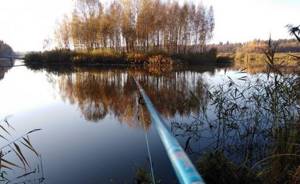
In general, gudgeon fishing begins almost immediately after the ice melts. As the water warms up, the bite becomes more confident, intensifying until the start of a long spawning season. On average, the spawning time of minnows falls in April - May, and can last up to two months. At this time, the fish move into shallow water in schools. This is where she should be guarded.
In spring, gudgeon bite all day, starting from the very early morning and ending late in the evening. In summer, during hot hours, on the contrary, there is practically no bite. At night, the gudgeon is not active; it descends closer to the bottom and does not rise until dawn. In the morning hours, the entire flock is still at the bottom, but only after noticing the prey does the fight begin. Each minnow tries to grab it first. Therefore, in the morning hours, the fisherman will not have to wait long for the first bites.
Recommended reading: Common roach
The fish actively bite after rains, when muddy water from the banks rushes into the rivers. Such streams carry a lot of food with them. Thanks to the sensitivity of its antennae, it is not difficult for it to find prey in muddy water.
